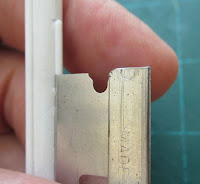My Semroc Andromeda was a pre-production kit, given to me to help produce the instructions. I got the kit at NARAM 60, almost two years ago.
I built the kit without problems as I did the line drawings. All went great, until I applied the (laser burned) chrome wrap. The black striping was cut a little to deep. I couldn't transfer the wrap onto the model without it breaking up into many strips.
The model sat finished, without the chrome wrap for quite a while. I finally got around to making a wrap yesterday and applying it tonight.
I've used this technique before when a printed chrome piece was needed.
I drew up three roll bar rectangles. The middle set was drawn to the width of the kit supplied wrap. Past experience has taught me to make a few more, one a bit narrower and a third wrap a little wider. The width difference was almost 1/16".
This gives me some room to play with and adjusts for tube diameter and paint thickness.
These were printed up on to clear decal paper.
I first cut Monokote chrome trim piece to the width of the wrap supplied in the kit. It turned out to be about 1/16" short! Maybe the third, wider decal wrap will fit.
A second test piece of chrome trim was cut to allow a slight overlap. When a chrome wrap overlaps itself, it's very hard to see the seam.
Notice in the above picture, a wrap of masking tape is set around the tube for a straight, around the tube reference line. The upper side of the tape is 1 1/2" from the top of the centering ring.
When rolling on the chrome piece, leave most of it on the backing. Try not to touch the sticky underside.
Roll the chrome on, smoothing out any trapped air as you go. Keep the bottom edge of the chrome wrap on the top of of the tape.
More tomorrow-





















































